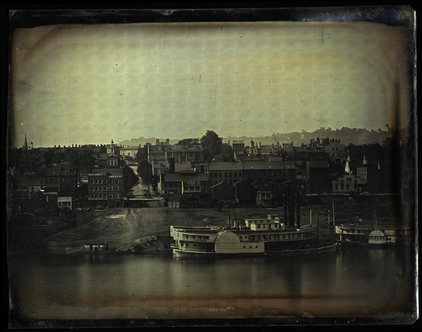
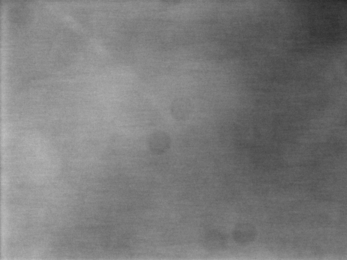

The daguerreotype is considered the first widely used photographic process. This remarkable invention, or discovery, forever changed the world in 1839 by giving it the first light capturing medium. These direct positive images on a silvered copper plate provide remarkable resolution of what are inevitably the first photographic images of a person or a place. Because they are unique and irreproducible, these first images are valued for their historical record and documentation.
High-resolution digitization of daguerreotypes is a relatively new enterprise, and not easy since they act very much like mirrors (at the right angle they appear to contain the negative image, for example). GEH is in the forefront of developing the relevant techniques. We expect to be inventing and disseminating effective practices rather than following them. A panorama owned by the Cincinnati Public Library was loaned to GEH for digitization (and used in the work described here). It is made up of eight daguerreotypes, and initially we are working with them at a scale in which each takes 768 sub-images (tiles) of 1388 by 1040 color pixels. That is 1.1 billion (giga-) red, green, and blue pixels, at about 2.8 microns (micrometers) per pixel.
Scanning or digitization process may introduce systematic distortions (due, for example, to lighting variation, or sensor element non-uniformity) that can be removed to produce a ``truer original'' archival image. Beyond this, the original artifact is often degraded, and has lost visual information due to dust particles, scratches, and chemical damage. There are generally far too many of these for manual annotation to be practical for a large database. However, modern machine vision techniques can provide trainable, automatic systems for detecting, classifying, locating, and indexing such defects. The result of such processing is an ``annotated original'' image and database in which defects can be displayed or queried by type or location. The next step is automatic or human-aided ``defect correction'' (dust and scratch removal, filling in larger defects, correcting for degenerative processes like tarnish).
Systematic
brightness
inaccuracies
can result from illumination variations,
internal reflections, etc. in each
scanning run.
They may not be
not visible in isolation, but belowleft they show up in the 768 tiles used for one
image. Using the relatively featureless sky tiles, the average anomaly
map for the tiles can
be made (below right) and used to correct all the tiles:


Context-aware processing can use different methods to detect dust
effects
in different image contexts. Here, the left column is original
images. The middle column is the result from considering average
brightnesses in small windows: it
has good detection in the sky area but too many false positives
in tree-leaf texture. The right column uses a
Laplacian of Gaussian technique, which has too many false negatives
in the sky but does well in tree leaves.

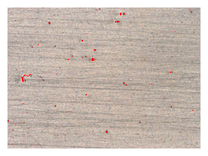
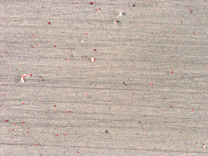
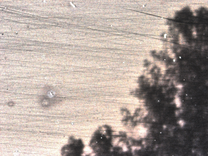


Detecting and isolating scratches is useful not just because they are defects, but because they arise during plate-polishing prior to exposure, and thus contain information about provenance: different studios had different polishing techniques. Standard frequency-domain analysis finds parallel scratches. Below, the top row is original image and its power spectrum, middle row is a manually-created mask and the resulting filtered image, and bottom is an automatically-generated mask and filtered image.
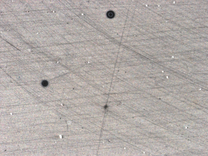

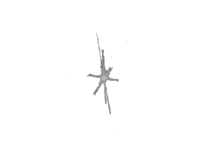
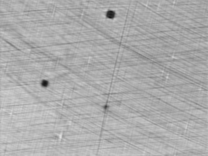
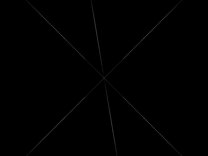

We are investigating the use of discriminative probabilistic graphical models to classify image defects such as tarnish, the effect of various chemical impurities included in the silver matrix, severe scratches, etc.

Tang, Messing, Nelson, Ardis, Brown
Rehmeyer, Julie: "History Exposed", WIRED 18-08 (August 2010),
pp. 124-129.
History Exposed.
Paul A. Ardis,
Ross Messing,
Xiaoqing Tang,
Christopher M. Brown,
Randal C. Nelson,
Patrick Ravines,
Ralph Wiegandt:
"Digital Analysis and Restoration of Daguerreotypes Using Cluster
Computing".
UR Computer Science Department Technical Report 954, Jan. 2010.
URCS TR 954.
Paul A. Ardis: "Controlling and Evaluating Inpainting with Attentional Models", UR Computer Science PhD Thesis, Feb. 2010.